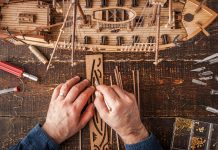Scale Explained: How to Choose the Best Model Size for You
So you’ve decided to start your first scale model, and you’re now scrolling through our range of models to decide which is your favourite. There are a number of factors that may settle your decision – a recommendation from a friend, the way it looks, or the fascinating story behind it. But what about size? How do you decide what scale is best, and what does model building scale even mean? Models come in a range of scales, the most common being 1:4, 1:8, 1:12, 1:16, 1:18, 1:24, 1:48, and 1:72. Choosing a scale that works for you is the first big step in mastering your model builds.
Once you have an understanding of the size you are working with, you can really show off your creative building
Unless you get transported into an alternate universe, or you are filthy rich, scale models are always several sizes SMALLER than the real-life object they represent. When reading the scale then, the number on the left side of the colon (usually 1) represents the model, and the number on the right-hand side represents how many times larger the original object is by comparison.
To clarify this concept a little better, we’ve listed a few of our current items with their scales, model sizes and original sizes:
| ITEM |
SCALE |
MODEL LENGTH |
ACTUAL LENGTH |
| Senna McLaren MP4/4 |
1:8 |
552mm |
4416mm |
| Hummer H1 |
1:8 |
570mm |
4560mm |
| HMS Surprise |
1:48 |
1334mm |
64032mm |
| HMS Victory |
1:84 |
1250mm |
105000mm |
| Spitfire |
1:12 |
760mm |
9120mm |
| D51 200 Steam Locomotive |
1:24 |
880mm |
21120mm |
| Suzuki GSX 1300R Hayabusa |
1:4 |
535mm |
2140mm |
| Millennium Falcon |
1:1 |
808mm |
808mm |
As you can see, the larger the original object is, the more it needs to be scaled down to a manageable model size. You’ll also notice that we’ve included the Millennium Falcon in the list, with a scale of 1:1. This particular model is the exact same size as the prop used in the Star Wars films, not the actual Millennium Falcon. The official length of this legendary starship is 34.75 metres – could you imagine building a scale model that size?!
So apart from removing the need for a football field to display your finished product, what else is there to know about scale?
Simply Put, Size Matters
A lot of the models on offer from ModelSpace are big, with our ships in particular being very large. While this could potentially make displaying them harder, there are a couple of key benefits:
- The parts are bigger and therefore easier to handle.
- The detail you can achieve is much greater, and gives you a lot more freedom to add your own interpretations and flourishes.
Note: We have a range of sturdy and practical display stands available to suit any of the ModelSpace models, so you can easily display your finished models without any hassles.
Conversely, while smaller models are generally much faster to complete and can be displayed almost anywhere, they can be quite fiddly when you have to put them together or paint them – of course for some this challenge is what it’s all about.
Scale Keeps It Consistent
Let’s say you’re putting together your brand new Hummer H1 model. You’ve completed the model according to the kit, but you’re feeling inspired, and you want to convert this standard Hummer into a post-apocalyptic battle machine. All that’s needed now is a slick paint job, a couple of cannons, and a mean roof-mounted machine gun to seal the deal. But how big should these attachments be?
Scale takes the guesswork out of modifications. For example, if you’re using a real cannon as your reference, simply take the measurements of the original cannon and divide it by the scale of the Hummer (i.e. divide by 8, taken from the 1:8 scale) to give you the scaled cannon size.
By using your current model as your point of reference, you can easily keep the breadth, width, length and height of your modifications uniform, thus avoiding compromising the overall look of your model by using incorrectly sized parts.
Scale Conversion Calculator
If you’re still a bit confused, this Scale Conversion Calculator from Jimbob-Wan allows you to calculate the scale size accurately. If you have the measurements of a full-size vessel or any part of it, you can use this calculator to match any part to almost any scale both in inches and millimetres.
Whether you want several models that you can spread out on the shelves, or one large model to take pride of place on the coffee table, scale is one of the first aspects you should consider. Once you have an understanding of the size you are working with, you can really show off your creative building – something we love and wholeheartedly encourage!
Do you have a scale model you’re working on or about to start? Share your build diary and some photos on the ModelSpace forum or on the ModelSpace Facebook page – we’d love to see them!






